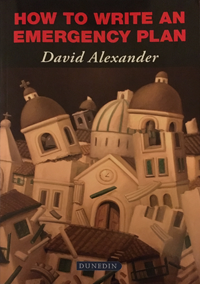
Reviewed by Adjunct Associate Professor Brett Aimers, James Cook University
Published by Dunedin Academic Press
Author: David Alexander, University College, London, United Kingdom
ISBN: 9781780460130
In his third related publication, How to Write an Emergency Plan, David Alexander once again provides an engaging and principles-based book, suitable for the novice and experienced emergency, disaster or crisis practitioner.
This book, while authored in the United Kingdom, is broadly applicable to those in a planning role, irrespective of their location, the maturity and funding of their systems and processes or the specific nature of a hazard or context they may be focused on (transport infrastructure or human health, for example).
How to Write an Emergency Plan provides the reader with an appreciation of the need for and importance of planning; before, during and after an emergency, disaster or crisis. In doing so, Alexander places an emphasis on the processes involved in planning versus the applicability of a rigid, untested document.
This book touches on a number of topical or emerging themes for a contemporary emergency, disaster or crisis planner, which include the importance of identifying lessons, the value of training coupled with practical experience and the rapidly shrinking degree of tolerance for the absence of plan.
In this book, Alexander not only considers the range of traditional circumstances, scenarios and hazard types (or sources) including natural hazards (fire and flood, for example) but extends to those that are less frequent, yet increasingly appearing on the risk profiles of governments. These include critical infrastructure failure, animal emergency diseases and human (public) health emergencies. In doing so, the book underlines the importance of acknowledging that while a type or classification of emergency, disaster and crisis may yield some common characteristics or indicate a consistent response, they are each different or unique and should be treated as such.
Pleasingly, How to Write an Emergency Plan explores the contemporary process of identifying lessons and their translation to recommendations and practice. The value of a lessons-management approach cannot be underestimated and should feature as a component of all emergency, disaster or crisis management systems, plans and arrangements.
An equally important concept for the emergency planner is explored in this book is that of resilience and, in doing so, has identified four interfaces (pillars) of resilience, being:
- social
- technological
- psychosocial
- physical.
As an experienced planner, I find this approach to understanding and considering resilience, from an emergency, disaster or crisis perspective, a refreshing one.
Not satisfied with delivering a useful resource for an emergency, disaster or crisis planner, in his conclusion, Alexander looks forward and provides the reader with an insight as to how the role of a planner may be perceived under a variety of more than probable scenarios.
I congratulate David Alexander on producing an very valuable resource and commend its reading to those with an emerging or established emergency, disaster or crisis planning role.


